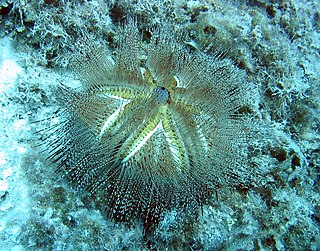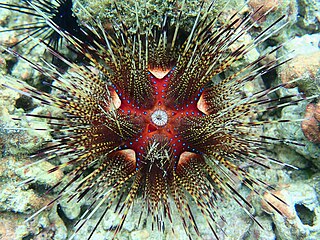
Astropyga radiata, the red urchin, fire urchin, false fire urchin or blue-spotted urchin, is a species of sea urchin in the family Diadematidae. It is a large species with long spines and is found in the tropical Indo-Pacific region. It was first described in 1778 by the German naturalist Nathaniel Gottfried Leske.

Coelopleurus is an extant genus of echinoids with fossil records dating back to the Eocene, with remains found in Europe and North America.
Ammotrophus platyterus is a species of sea urchin of the family Temnopleuridae. Their armour is covered with spines. It came from the genus Ammotrophus and lives in the sea. Ammotrophus platyterus was first scientifically described in 1928 by Hubert Clark.
Araeosoma leptaleum is a species of sea urchin of the family Echinothuriidae. Their armour is covered with spines. It is placed in the genus Araeosoma and lives in the sea. Araeosoma leptaleum was first scientifically described in 1909 by Alexander Emanuel Agassiz & Hubert Lyman Clark.
Araeosoma paucispinum is a species of sea urchin of the family Echinothuriidae. Their armour is covered with spines. It is placed in the genus Araeosoma and lives in the sea. Araeosoma paucispinum was first scientifically described in 1924 by Hubert Lyman Clark, an American zoologist.

Araeosoma thetidis is a species of sea urchin of the family Echinothuriidae. This species can be found in deep sea off Australia and New Zealand. A. thetidis was first scientifically described in 1909 by Hubert Lyman Clark.

Echinometra is a genus of sea urchins in the family Echinometridae.

Astropyga is a genus of sea urchins of the family Diadematidae. Their armour is covered with spines. Astropyga was first scientifically described in 1855 by John Edward Gray.
Astropyga nuptialis is a species of sea urchins of the family Diadematidae. Their armour is covered with spines. Astropyga nuptialis was first scientifically described in 1958 by Tommasi.

Astropyga pulvinata is a species of sea urchins of the family Diadematidae. Their armour is covered with spines. Astropyga pulvinata was first scientifically described in 1816 by Jean-Baptiste de Lamarck.
Brisaster kerguelenensis is a species of sea urchins of the Family Schizasteridae. Their armour is covered with spines. Brisaster kerguelenensis was first scientifically described in 1917 by Hubert Lyman Clark.

Caenopedina hawaiiensis is a species of sea urchins of the Family Pedinidae. Their armor is covered with spines. Caenopedina hawaiiensis was first scientifically described in 1912 by Hubert Lyman Clark.

Centrostephanus tenuispinus is a species of sea urchins of the Family Diadematidae. Their armour is covered with spines. Centrostephanus tenuispinus was first scientifically described in 1914 by Hubert Lyman Clark.
Chaetodiadema africanum is a species of sea urchins of the Family Diadematidae. Their armour is covered with spines. Chaetodiadema africanum was first scientifically described in 1924 by Hubert Lyman Clark.
Chaetodiadema pallidum is a species of sea urchins of the Family Diadematidae. Their armour is covered with spines. Chaetodiadema pallidum was first scientifically described in 1907 by Alexander Emanuel Agassiz and Hubert Lyman Clark.
Chaetodiadema tuberculatum is a species of sea urchins of the Family Diadematidae. Their armour is covered with spines. Chaetodiadema tuberculatum was first scientifically described in 1909 by Hubert Lyman Clark.
Chondrocidaris brevispina is a species of sea urchins of the Family Cidaridae. Their armour is covered with spines. Chondrocidaris brevispina was first scientifically described in 1925 by Hubert Lyman Clark.
Cidaris rugosa is a species of sea urchins of the Family Cidaridae. Their armour is covered with spines. Cidaris rugosa was first scientifically described in 1907 by Hubert Lyman Clark.
Clypeaster euclastus is a species of sea urchins of the Family Clypeasteridae. Their armour is covered with spines. Clypeaster euclastus was first scientifically described in 1941 by Hubert Lyman Clark.

Araeosoma is a genus of deep-sea sea urchins in the family Echinothuriidae.











